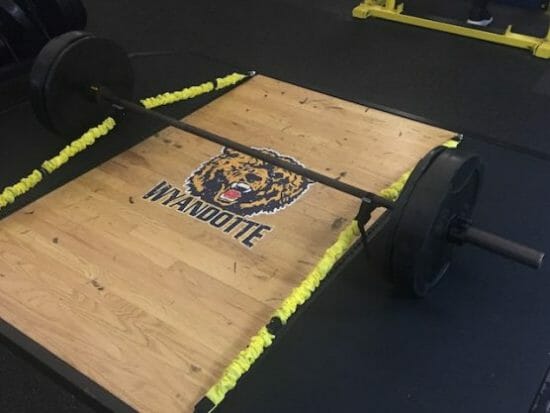Retrofit your weight room to improve strength & power: a case study

Retrofit your weight room to improve strength & power: a case study
In this blog, George Filipiak, better known as “Coach Flip”, from Roosevelt High School in Wyandotte, Michigan shares his experience with Perform-X.
Coach Flip was first introduced to Perform-X at the Spartan Strength and Conditioning clinic at Michigan State University. He had his racks and above ground platforms retrofitted with the Trak-X system, an innovative metal strip that provides a safe and effective anchoring point for cord-loaded applications such as the Jump-X and Lift-X cords. The Trak-X was simply attached to the base of the rack for using the Squat-X and Bench-X cords (see photo below). On the above ground platforms, a 4-foot piece of Trak-X was installed by cutting away the inner edge of the drop zone rubber (see photo below) for use of the Dead-X cord and the Jump-X system.
Here’s how Coach Flip programs the Jump-X and Lift-X cords.
JUMP-X SYSTEM
 We use the jump system two days per week with a three workout rotation.
We use the jump system two days per week with a three workout rotation.
Day 1: Body weight and cord-loaded resistance jumps. We will usually incorporate a combination of the following:
- Squats
- Squat jumps
- Power jumps
- Scissor jumps
- Lunge jumps
Day 2: Cord-loaded step-ups and box jumps
Day 3: Multi-directional plyometrics (dot drills); both unloaded and cord-loaded single and double leg. This adds a horizontal component to our vertical plyometric work. Click here for more information on incorporating multi-directional plyometrics and cord-loaded applications.
Lift-X Cords: Squat, Bench, Dead
 We will bench press and squat (or front squat) twice per week, and incorporate the Lift-X cords every other lift by gradually increasing the load from the variable resistance (cord) application. We use between 30-50% of the total load to be accounted for by the cord resistance. For example, if the assigned load is 200 pounds, we use 140 pounds of external load (bar + plates) and the remaining 60 pounds from the cord resistance which can be found on the back of the QRC (Quick Reference Chart) provided by Perform-X. This varies by cord color and loop.
We will bench press and squat (or front squat) twice per week, and incorporate the Lift-X cords every other lift by gradually increasing the load from the variable resistance (cord) application. We use between 30-50% of the total load to be accounted for by the cord resistance. For example, if the assigned load is 200 pounds, we use 140 pounds of external load (bar + plates) and the remaining 60 pounds from the cord resistance which can be found on the back of the QRC (Quick Reference Chart) provided by Perform-X. This varies by cord color and loop.
During the lift, it is emphasized to be explosive during the ascent or concentric phase of the exercise. Following a set of bench press, we will also do something explosive like a clap pushup, medball smash, etc. However, on cord-loaded days this is scaled back to avoid shoulder soreness.
We have found this variable loading has helped our athletes get stronger without always working around their 1RM/3RM.
We also incorporate cord-loaded deadlift every other lift. We started with lighter weight on the bar and the addition of the cord resistance. This seemed to help our athletes improve form and helped in their power development.
